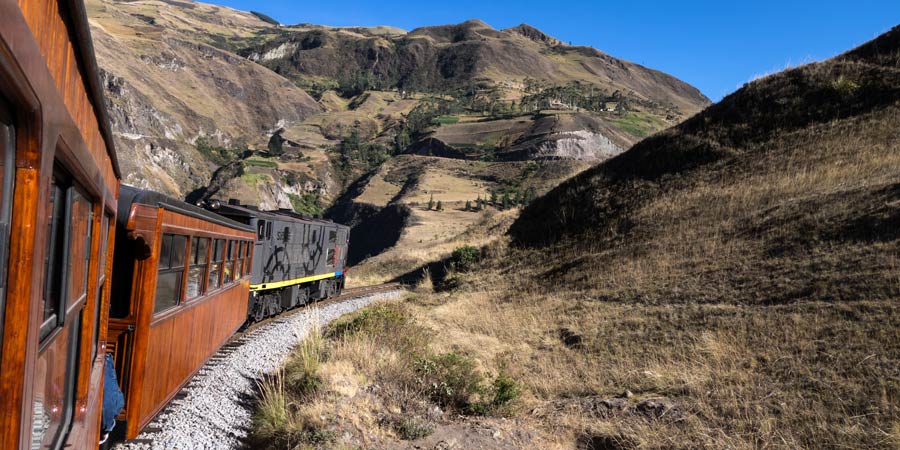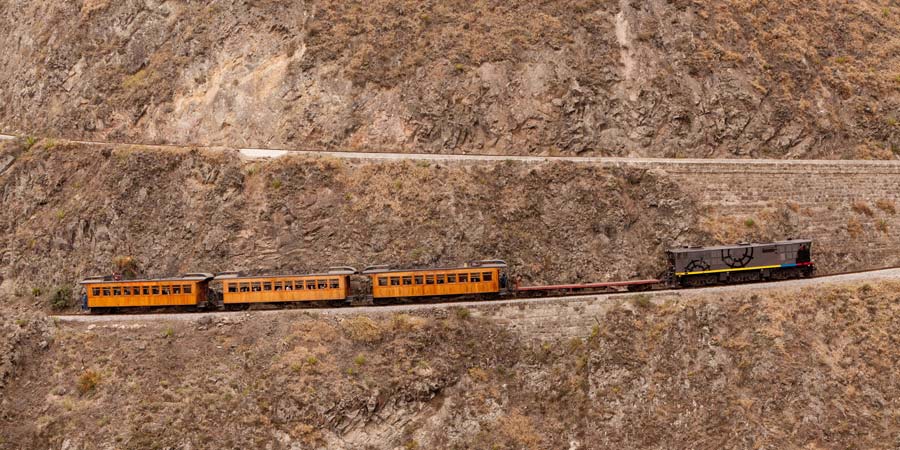
Guests enjoying an escorted rail tour of Ecuador with Great Rail Journeys may experience an exhilarating ride on the Devil's Nose Train. The train takes its name from the towering rock face of Cóndor Puñuna (Condor Mountain) which presented a seemingly impassable obstacle during the construction of Ecuador's first railway line at the beginning of the nineteenth century. Nicknamed El Nariz del Diablo- 'the Devil's Nose', the troublesome mountainside and the problem it posed were finally surmounted in 1908 by an ingenious feat of railway engineering.
A series of long, curving switchbacks were carved directly into the face of the rock, allowing the train to gradually ascend or descend the Devil's Nose for more than eight hundred metres by slowly shunting backward and forward to negotiate the steep switchbacks. Today, the twelve-kilometre stretch of the original railway forms part of an exhilarating journey through beautiful mountain scenery and traditional market towns. Naturally very with tourists, the line is also a favourite of rail enthusiasts, who appreciate the outstanding engineering skill required to complete the line.
The Devil's Nose Journey
We join the train in Alausi, an historic town perched on
the side of a valley more than two thousand metres above sea level.
From here the Devil's Nose Train makes its
decent down the precipitous face of the mountain.
Taking a leisurely pace by necessity, the train
enables our guests to fully appreciate the beauty of the
surrounding scenery. Rolling green hills and mountain peaks
dominate the landscape on all sides, but as the train zig-zags its
way down it also encounters the occasional rural village and open
farmland.
At the base of Condor Mountain the Devil's
Nose Train reaches its destination; the small village of
Sibambe. Here our guests are treated to a display of traditional
dance and may explore the local museum and gift shop. There is also
a café at which refreshments can be bought.

Other facts about the Devil's Nose Train
Until recently, the only section of the original 464-kilometre Guayquil-Quito Railway that was still in use was the twelve kilometre section between Alausi and Sibambe. Lack of funding and subsequent damage to the railway by 1998's devastating El Niño storm saw the gradual closure of the historic line.
A decade later, Ecuador's president, Rafael Correa, allocated a budget of $245million for the reconstruction and modernisation of the railway's infrastructure and rolling stock; a project that came to fruition in 2013 when the entire Guayquil-Quito Railway line was officially reopened.
As a consequence of this investment, the old trains that use to ascend and descend the Devil's Nose have been replaced with new and modern tourist trains. Prior to the introduction of these improved trains, visitors would routinely travel on the roof of the original trains in order to obtain the best possible views of Ecuador's magnificent scenery; this practice is now prohibited.
